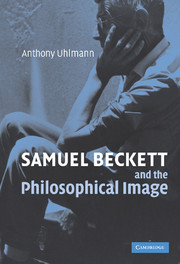23 results
12 - Philosophies
- from Part III - Mediations
-
-
- Book:
- The Cambridge Companion to J. M. Coetzee
- Published online:
- 26 April 2020
- Print publication:
- 30 April 2020, pp 206-220
-
- Chapter
- Export citation
Chapter 8 - Affect, Meaning, Becoming, and Power: Massumi, Spinoza, Deleuze, and Neuroscience
- from I - Origins
-
-
- Book:
- Affect and Literature
- Published online:
- 16 January 2020
- Print publication:
- 06 February 2020, pp 159-174
-
- Chapter
- Export citation
11 - The Eyes of the Mind: Proportion in Spinoza, Swift, and Ibn Tufayl
-
-
- Book:
- Spinoza's Philosophy of Ratio
- Published by:
- Edinburgh University Press
- Published online:
- 28 April 2021
- Print publication:
- 08 March 2018, pp 155-168
-
- Chapter
- Export citation
8 - Beckett’s Intertexts
- from Part II - Poetics
-
-
- Book:
- The New Cambridge Companion to Samuel Beckett
- Published online:
- 05 February 2015
- Print publication:
- 12 January 2015, pp 103-113
-
- Chapter
- Export citation
Notes on Contributors
-
-
- Book:
- The New Cambridge Companion to Samuel Beckett
- Published online:
- 05 February 2015
- Print publication:
- 12 January 2015, pp ix-xii
-
- Chapter
- Export citation
9 - Deleuze, Ethics, Ethology, and Art
-
-
- Book:
- Deleuze and Ethics
- Published by:
- Edinburgh University Press
- Published online:
- 12 September 2012
- Print publication:
- 09 May 2011, pp 154-170
-
- Chapter
- Export citation
3 - Expression and Affect in Kleist, Beckett and Deleuze
- from Act I Deleuze on Theatre: Artaud, Beckett and Carmelo Bene
-
-
- Book:
- Deleuze and Performance
- Published by:
- Edinburgh University Press
- Published online:
- 12 September 2012
- Print publication:
- 21 May 2009, pp 54-70
-
- Chapter
- Export citation
Notes
-
- Book:
- Samuel Beckett and the Philosophical Image
- Published online:
- 22 September 2009
- Print publication:
- 14 December 2006, pp 150-180
-
- Chapter
- Export citation
5 - Cogito nescio
-
- Book:
- Samuel Beckett and the Philosophical Image
- Published online:
- 22 September 2009
- Print publication:
- 14 December 2006, pp 86-113
-
- Chapter
- Export citation
Introduction
-
- Book:
- Samuel Beckett and the Philosophical Image
- Published online:
- 22 September 2009
- Print publication:
- 14 December 2006, pp 1-4
-
- Chapter
- Export citation
7 - The Ancient Stoics and the ontological image
-
- Book:
- Samuel Beckett and the Philosophical Image
- Published online:
- 22 September 2009
- Print publication:
- 14 December 2006, pp 129-146
-
- Chapter
- Export citation
4 - The philosophical imaginary
-
- Book:
- Samuel Beckett and the Philosophical Image
- Published online:
- 22 September 2009
- Print publication:
- 14 December 2006, pp 65-85
-
- Chapter
- Export citation
6 - Beckett, Berkeley, Bergson, Film: the intuition image
-
- Book:
- Samuel Beckett and the Philosophical Image
- Published online:
- 22 September 2009
- Print publication:
- 14 December 2006, pp 114-128
-
- Chapter
- Export citation
1 - Representation and presentation: Deleuze, Bergson, Peirce and ‘the image’
-
- Book:
- Samuel Beckett and the Philosophical Image
- Published online:
- 22 September 2009
- Print publication:
- 14 December 2006, pp 5-23
-
- Chapter
- Export citation
3 - Relation and nonrelation
-
- Book:
- Samuel Beckett and the Philosophical Image
- Published online:
- 22 September 2009
- Print publication:
- 14 December 2006, pp 36-64
-
- Chapter
- Export citation
2 - Beckett's aesthetic writings and ‘the image’
-
- Book:
- Samuel Beckett and the Philosophical Image
- Published online:
- 22 September 2009
- Print publication:
- 14 December 2006, pp 24-35
-
- Chapter
- Export citation
Conclusion
-
- Book:
- Samuel Beckett and the Philosophical Image
- Published online:
- 22 September 2009
- Print publication:
- 14 December 2006, pp 147-149
-
- Chapter
- Export citation
Works cited
-
- Book:
- Samuel Beckett and the Philosophical Image
- Published online:
- 22 September 2009
- Print publication:
- 14 December 2006, pp 181-188
-
- Chapter
- Export citation
Frontmatter
-
- Book:
- Samuel Beckett and the Philosophical Image
- Published online:
- 22 September 2009
- Print publication:
- 14 December 2006, pp i-vi
-
- Chapter
- Export citation

Samuel Beckett and the Philosophical Image
-
- Published online:
- 22 September 2009
- Print publication:
- 14 December 2006



